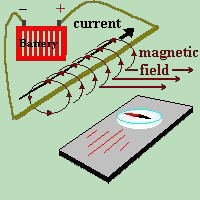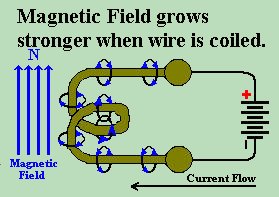


ElectromagnetsThere are actually 2 types of magnetism:
2.) Permanent Steel or hard iron, which is difficult to magnetize, retains the majority of its magnetism long after it has been removed from the magnetic field. This type of magnet is called a PERMANENT MAGNET . Permanent magnets are generally made in the shape of a bar or a horseshoe. Of the two shapes, the horseshoe type has the stronger magnetic field because the magnetic poles are closer to each other. Horseshoe magnets are used in the construction of headphones. Loudspeakers, on the other hand, generally use a type of Bar magnet. It has been found that when a compass is placed in close proximity to a wire, and an electrical current flows through the wire, the compass needle will turn until it is at a right angle to the conductor. Since a compass needle lines up in the direction of a magnetic field, there must be a magnetic field around the wire, which is at right angles with the conductor!  Science has discovered then, that wires which carry current have the same type of magnetic field that exists around a magnet! We say that an electric current
INDUCES
a magnetic field.
Science has discovered then, that wires which carry current have the same type of magnetic field that exists around a magnet! We say that an electric current
INDUCES
a magnetic field.
If you closely examine the picture on the right, you will find that there are "rings" circling about the wire. These rings represent the magnetic lines of force which exist around a wire which carries an electric current. They are strongest directly around the wire, and extend outward from the wire, gradually decreasing in intensity. You will also note that the compass needle is steady, and not spinning. This indicates that the magnetic field goes in a ring around the wire. It also travels in a specific direction. 
 No matter which way we turn or twist the wire, the left hand rule applies. But
what happens if we put a loop in the wire? When the wire is looped, as you
will see from the picture on the right, the little magnetic fields that wrap
around the wire cross through each other's path. If you use the left hand rule,
and follow around the coils of the wire, you will find that the magnetic field
acts as if it is running through the hole inside of the loop. (If the loop were
a donut, the magnetic field would go through the hole in the donut). Thinking
along these lines... if we put a dozen donuts side to side, with a stick going
through the holes, the magnetic field would follow the stick.
No matter which way we turn or twist the wire, the left hand rule applies. But
what happens if we put a loop in the wire? When the wire is looped, as you
will see from the picture on the right, the little magnetic fields that wrap
around the wire cross through each other's path. If you use the left hand rule,
and follow around the coils of the wire, you will find that the magnetic field
acts as if it is running through the hole inside of the loop. (If the loop were
a donut, the magnetic field would go through the hole in the donut). Thinking
along these lines... if we put a dozen donuts side to side, with a stick going
through the holes, the magnetic field would follow the stick.

INDUCTOR SOLENOID COIL 
There are several factors which determine the strength of a given electromagnet. They are:
2). The number of turns - the greater the number of turns in a coil, the greater the field. 3). The PERMEABILITY of the core.
 To the right is a picture of a " variable " air core coil. This particular
coil is adjustable in value, based on a moving " tap " in the coil, which rolls
along the outside of the coil as the spindle is turned. Sometimes this is
called a " roller inductor ". As the spindle is turned, the coil itself
rotates, and the tap moves along the length of the coil, changing its "
electrical length ". Of course this is just one example of the many types and
shapes of coils that exist. The key thing to remember is that any length of
wire that is wrapped up into a coil, has the same electrical properties as a
coil.
To the right is a picture of a " variable " air core coil. This particular
coil is adjustable in value, based on a moving " tap " in the coil, which rolls
along the outside of the coil as the spindle is turned. Sometimes this is
called a " roller inductor ". As the spindle is turned, the coil itself
rotates, and the tap moves along the length of the coil, changing its "
electrical length ". Of course this is just one example of the many types and
shapes of coils that exist. The key thing to remember is that any length of
wire that is wrapped up into a coil, has the same electrical properties as a
coil.
Just as conductance has an opposite - resistance; permeability also has an opposite - reluctance. RELUCTANCE is mathematically the reciprocal of PERMEABILITY. The unit of measurement for reluctance is the REL or OERSTED , and its symbol is Ö . Voltage is the measurement for Amplitude of an electrical circuit. Magnetism also has a counterpart for this, which is called MAGNETOMOTIVE FORCE . Magnetomotive force is the force which produces the magnetic lines of force or FLUX . The unit of magnetomotive force is the GILBERT , and its symbol is G . The formula for finding the value of G is as follows:
Where:
I = the current flowing through the coil in Amperes |
| (On The Following Indicator... PURPLE will indicate your current location) | ||||||||||||||||||||||||
| 1 | 2 | 3 | 4 | 5 | 6 | 7 | 8 | 9 | 10 | 11 | 12 | 13 | 14 | 15 | 16 | 17 | 18 | 19 | 20 | 21 | 22 | 23 | 24 | 25 |
| 26 | 27 | 28 | 29 | 30 | 31 | 32 | 33 | 34 | 35 | 36 | 37 | 38 | 39 | 40 | 41 | 42 | 43 | 44 | 45 | 46 | 47 | 48 | 49 | 50 |
| 51 | 52 | 53 | 54 | 55 | 56 | 57 | 58 | 59 | 60 | 61 | 62 | 63 | 64 | 65 | 66 | 67 | 68 | 69 | 70 | 71 | 72 | 73 | 74 | 75 |
| Otherwise - please click to visit an advertiser so they know you saw their ad! |
